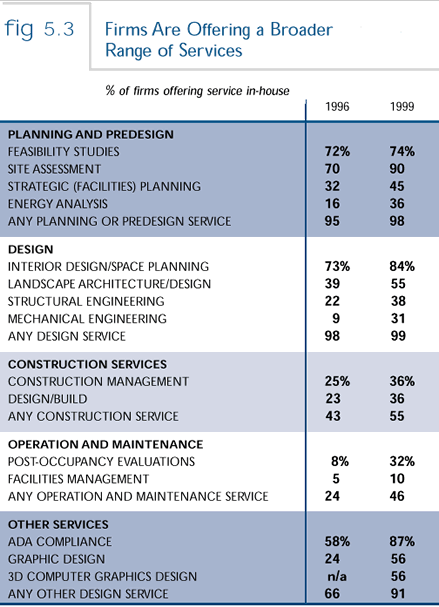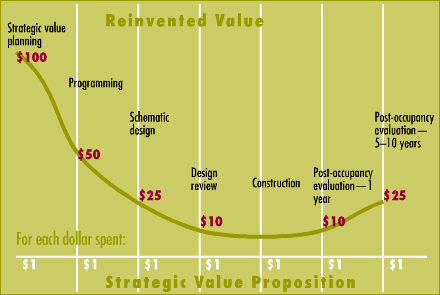

AIA Resident Fellow, Marketplace Research Trends
Definitions of words and how they evolve over time has always fascinated me, especially architecture terms. For instance, "design/build," which used to connote a method to reduce costs at the expense of the design and even the client's strategy, now is recognized as an integrated design/construction process that respects the concerns of the client, architect, and contractor. Likewise, "value engineering," which used to define a process to save money in the short term (client and building performance be damned), now means using analysis to achieve maximum performance of the entire design process and the building's life cycle. We need to be aware of how our adjusted perception—and resulting terminology—contributes to the reinvention of the architectural profession.
The traditional approach to the design process begins with the architect's assets, core competencies, and a desire to create a product that matches (hopefully!) the client's priorities. The new approach takes on the reverse: defining the client's priorities, then acquiring or improving the skill sets, talent, and knowledge needed to create products that meet the client's needs.
Defining "architect
services"
One of the most effective tools we have for monitoring change within the
profession is the AIA Firm Survey. Comparing the two latest firm surveys
shows that from 1996 to 1999, the number of firms offering expanded services
increased significantly. Comparing the three latest surveys, we find also
that expanded services have increased in profitability. In 1990, expanded
services represented 22 percent of total revenue; in 1999, it was 39 percent.
From 1990 to 1999, the demand for basic services increased by 86 percent;
the demand for expanded services increased by 313 percent. The following
chart from the AIA Firm Survey 2000–2002
indicates the percentage of firms offering particular services in 1996
and 1999. It is important to note that firms are offering these expanded
services in addition to design services. (Figure 5.3)

The Firm Survey also tells us that during the prosperous times we enjoyed throughout most of the 1990s, clients began increasingly to challenge the architect to provide greater leadership, accountability, and responsibility. Firms responded by expanding the service offering and the value proposition in different ways. For instance, large firms dominated the landscape and found economic stability by expanding their scopes of service. Small firms, on the other hand, sought stability through specialization, offering these services a la carte or in concert with other firms. The broadening of services also fostered the rise of multidisciplinary firms (Figure 1.3).

Taking an increasingly client-centric approach to services has freed architects somewhat from the tyranny of construction financial cycles by decreasing their reliance on basic design services as their sole bread and butter. From 1996 to 1999, basic design services declined as a source of revenue from almost 80 percent to just over 60 percent. It is fair to say that this approach to services provision is both planned (strategic), as firm principals set growth strategies and fulfill them, and by chance (opportunistic), as firm principals perceive unfulfilled client needs and expand to meet them. Expansion of services has also led to progressively diverse staffing as different skills are needed in architecture firms.
Defining "strategic
value planning"
Steve Kirk's research into value analysis leads to the term "strategic
value planning," which means using strategic thinking during project
planning so that the client gains maximum value. In fact, it appears that
many clients view these as the most important of all services. Clients
see the tremendous impact of setting proper design criteria, preparing
a quality model, and defining client and community quality and performance
expectations, Kirk asserts.
Kirk's findings show that clients recognize that there is a definite return on investment for strategic value planning services by the architect. Kirk estimates that every dollar spent in the planning phase saves $100 in the implementation phase. Every dollar spent in the programming phase after the strategy phase saves $50 in the implementation phase. These dollars can be reallocated into the project; meaning the architect is providing a true value-added service. The graphic below shows strategic planning fee dollars spent in various phases of the design process and their corresponding savings in implementation costs. (Notice that post-occupancy evaluations can offer value-added savings as well. Kirk considers construction services as the implementation phase.)

Kirk's research indicates that clients see—and are will to pay for—value-added services through all phases of the process. In fact, clients are willing pay a greater fee for more value-based services because they are used to paying other consultants for these services, Kirk says.
Defining the timing
of value
Brad Buchanan, AIA, of Buchanan Yonushewski Group, a design/build firm
in Denver speaks of the "timing of value." The biggest return
on an investment of time happens early in design-development phase, Buchanan
says. It increases in a smooth curve up from the concept phase. This added
value doesn't have to be seen as a cost savings that lowers the project
budget, Buchanan tells us. Rather, it can be viewed by the client as an
opportunity to keep the original budget, add value, and create a better
product.
Buchanan believes that for a design/build project, it is critical to be "dialed in to everything below dirt; everything concrete; and everything mechanical, structural, and civil." These are the components that set the project cost. Items like skins and finishes can be in outline spec form because they offer the most reliable unit costing. In other words, those items that are hard to change must be nailed down early in the process for the firm to strike the best deal and create the most value.
Creativity and flexibility are the keys to adding value to the deign/build process, according to Buchanan. Changes occur on every building project—all the time—and each creates a giant ripple effect, even though it may not be immediately felt. The tendency is to hammer each change to fit the earlier decision, rather than be open to new implications. If you can be open, as Buchanan says, "you can take the project from expected to extraordinary. You need to lean into the project and be a cheerleader for the possibilities."
Copyright 2001 The American Institute of Architects. All rights reserved.
![]()
|
What terms are you redefining? Share your thoughts by email, or 202-626-7450. Want to learn more? Visit the author's Web site. |
|